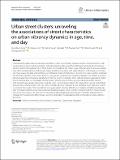| dc.contributor.author | Jang, Kee M. | |
| dc.contributor.author | Suh, Hanew | |
| dc.contributor.author | Haddad, Fadi G. | |
| dc.contributor.author | Sun, Maoran | |
| dc.contributor.author | Duarte, Fábio | |
| dc.contributor.author | Kim, Youngchul | |
| dc.date.accessioned | 2024-10-21T20:25:37Z | |
| dc.date.available | 2024-10-21T20:25:37Z | |
| dc.date.issued | 2024-10-03 | |
| dc.identifier.uri | https://hdl.handle.net/1721.1/157397 | |
| dc.description.abstract | Understanding urban vibrancy has been considered crucial to promoting human activities and interactions in public open spaces. Recent advancements in urban big data have facilitated the potential to understand and measure vibrancy patterns throughout cities. While streets are considered the center stage of human activity, previous studies have often overlooked their multifaceted nature and their association with urban vibrancy. In this study, we incorporate multi-source big data and combine a set of features that comprehensively describe the scale, function, and topology of street segments in two Seoul districts: Jung-gu and Gangnam-gu. Using these features, we employ a machine learning clustering technique to classify them into five distinct typologies. Then, with street-level aggregated mobile phone tracking data, we investigate whether street typology characteristics are associated with urban vibrancy with respect to age groups, time of day, and day types (weekends/weekdays). The results show varying relationships between street characteristics with age-, time- and day-vibrancy measures by the identified street typology. Further, we contrast the results of the two districts to evaluate urban vibrancy differences in organic and planned urban layouts. This study enables a more nuanced understanding of urban streets to better comprehend their impact on people’s use of street space. The derived novel insights could assist planners and designers to better pinpoint street management solutions for different age- and time-dependent needs based on the complexities in urban vibrancy dynamics. | en_US |
| dc.publisher | Springer Nature Singapore | en_US |
| dc.relation.isversionof | https://doi.org/10.1007/s44212-024-00058-4 | en_US |
| dc.rights | Creative Commons Attribution | en_US |
| dc.rights.uri | https://creativecommons.org/licenses/by/4.0/ | en_US |
| dc.source | Springer Nature Singapore | en_US |
| dc.title | Urban street clusters: unraveling the associations of street characteristics on urban vibrancy dynamics in age, time, and day | en_US |
| dc.type | Article | en_US |
| dc.identifier.citation | Jang, K.M., Suh, H., Haddad, F.G. et al. Urban street clusters: unraveling the associations of street characteristics on urban vibrancy dynamics in age, time, and day. Urban Info 3, 27 (2024). | en_US |
| dc.contributor.department | Senseable City Laboratory | en_US |
| dc.relation.journal | Urban Informatics | en_US |
| dc.identifier.mitlicense | PUBLISHER_CC | |
| dc.eprint.version | Final published version | en_US |
| dc.type.uri | http://purl.org/eprint/type/JournalArticle | en_US |
| eprint.status | http://purl.org/eprint/status/PeerReviewed | en_US |
| dc.date.updated | 2024-10-06T03:14:27Z | |
| dc.language.rfc3066 | en | |
| dc.rights.holder | The Author(s) | |
| dspace.embargo.terms | N | |
| dspace.date.submission | 2024-10-06T03:14:27Z | |
| mit.journal.volume | 3 | en_US |
| mit.journal.issue | 27 | en_US |
| mit.license | PUBLISHER_CC | |
| mit.metadata.status | Authority Work and Publication Information Needed | en_US |
